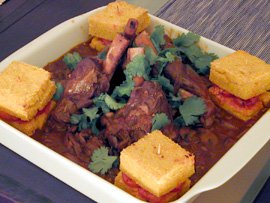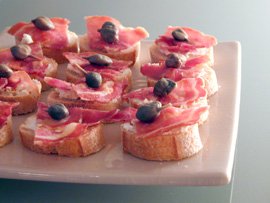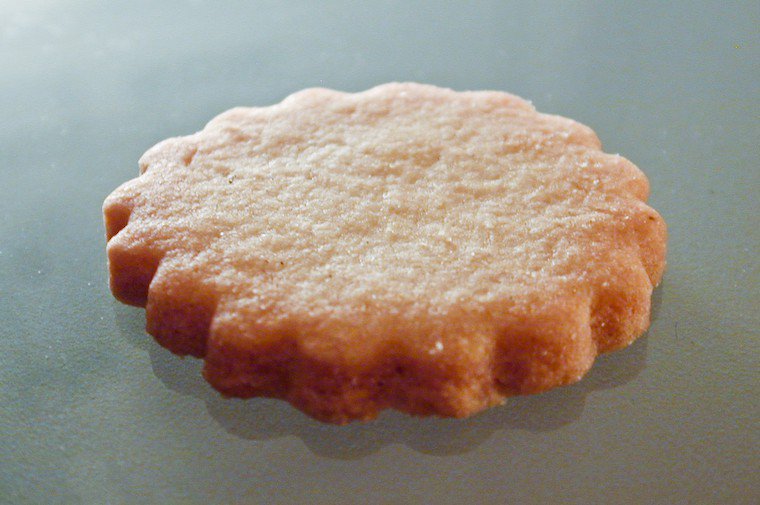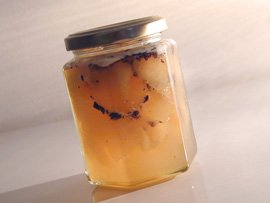
[Braised Lamb Shanks, Grilled Polenta Sandwiches]
…and this is part III of the dinner I served on Saturday, when I was (at long last) given the opportunity to meet Derrick and Melissa, dear friends from the Blogosphere now happily upgraded to dear friends from the Real World.
After a lively chat going in ten different directions — we were so excited to finally meet, where were we to start? — over a nice appetizer of crostini and anchoïade at the bar, Melissa, Derrick, Maxence and I sat down to the main course: lamb shanks, slowly cooked in the oven in a red wine and mushroom sauce, and served with sandwiches of grilled polenta squares.
In French, lamb shanks are called souris d’agneau, which literally means “lamb mice”, most probably because of their shape. Be it for the cuteness of the name or the tenderness of the cut, souris d’agneau is a favorite of mine I often fall for in restaurants.
This was my first time cooking it myself though, and the first hurdle to hop through was procurement: since la souris is the tip of le gigot (leg of lamb, a noble cut), the butcher will only sell them to you if he is sure to sell the rest, which will then be called gigot raccourci (shortened leg of lamb) and is ordered by people for whom the whole leg is a bit much.
I knew from Pascale that Picard, the life-saving frozen food store, sold lamb shanks and that they were quite good, but I thought — this is Derrick. And Melissa. I can’t serve them frozen meat, now can I? No. Nothing but fresh would do, and I ended up having to call and negociate with three different butchers (and yes, I did it all from the office, going out onto the terrace for a little butcher-calling privacy).
The first one didn’t do souris at all. I hung up. The second one thought for a bit (I could hear the furrowing of his brow over the line) and said “Four? I can’t do four. I can sell you one, but not four.” Um, okay. Let me think about it and call you back when I have just one person to feed. Thankfully the trusted Boucherie des Gourmets came to the rescue, not even blinking at the request (or I would have heard). They wrote down my order, and the next day I went to collect my four beauties.
The recipe here is inspired from a cookbook called Recettes Mijotées by Joanne Glynn, which is in fact an Australian book, originally titled Slow cooking. It includes slow-cooking recipes from all over the world and is lovely to look at. I’ve had it for over a year (we got it for our friend Ludo’s birthday, but I liked it so much we bought a copy for ourselves, too), but this was my first time trying anything from it — you know how it is, so many cookbooks, so little time.
I made a few minor adjustments to the recipe, using mushrooms where the author called for red peppers (I wanted to use those fabulous fresh mushrooms from the market) and changing a few of the ingredients and amounts here and there, just because I can’t help it. But since I have a lot to learn when it comes to meat cooking, her instructions as to the general process were most helpful, and everything went perfectly according to plan. I’m always impressed by slow-cooking and how magical it feels: you simply combine ingredients, close the lid or the oven door, cross your fingers and let the heat do the work!
With this I served grilled polenta squares, skewered into sandwiches with Italian cherry tomatoes in the middle: I adore polenta, I knew from last time that polenta and lamb worked well as a team, and the sandwiching sounded fun — the idea came to me while sitting in a particularly lengthy meeting during which my mind had escaped to the wonderful world of menu-planning and recipe invention, where everyone is happy and eats really well.
I was delighted with the appetizing look and the deep flavors of this dish, the moist meat having slow-cooked until you hardly needed a knife to cut it, the fragrant sauce thickened to a velvety consistency, and the grilled polenta squares being their usual crispy-outside-tender-inside selves. Maxence and my guests confirmed, both with and without words, that they shared my pleasure.
With this we drank a 2001 Corbières, a delicious wine from the Languedoc, as recommended by my wine seller after I carefully explained what the recipe was like, what went into it and what I would be serving it with — the pairing worked beautifully.







